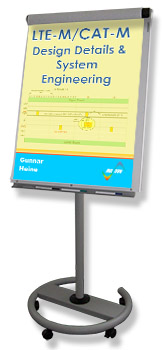 LTE-M / Cat-M1/M2 - Design Details & System Engineering
LTE-M / Cat-M1/M2 - Design Details & System Engineering
[2-day course, Euro 2,350.- (net) per participant]

Chapter 1: LTE-M and its Alternatives
- Long Range IoT-Technologies
SigFox & LoRA, NB-IoT, LTE-M, WiFI-Gateway + WAN-Connectivity
- Why LTE-M?
Deployment of NB-IoT and LTE-M
- BL-UE’s from Rel 12 – Rel 14
Cat-1 / Cat-1bis, Cat-0, Cat-M1 / Cat-M2, Cat-NB1 / Cat-NB2
- Reviewing NB-IoT
Nesting of NB-IoT: in-band, guard-band, stand-alone/re-farmed
Chapter 2: RF and PHY Operation Details
- Reviewing Properties of LTE-M / Cat-M1/M2
Narrow-Bands (Cat-M1) and Wide-Bands (Cat-M2), Narrow-Bands and Wide-Bands in 1.4, 3, 5, 10, 15 and 20 MHz
- Half-Duplex Operation and its Constraints
Type A Mode of Operation, Type B Mode of Operation, Frequency Retuning w/ Frequency Hopping
- Cat-M1/M2: Details of CE Levels 0 – 3
Configuration, Differences, Interpretation of System Information
- Cat-M1/M2: Details of CE Mode A and B
Configuration, No of Repetitions, Channels
- Maximum Coupling Loss (MCL) and CE-Modes
Free Space Path Loss, Calculation of the MCL, Link-Budget, Receiver Sensitivity, MCL Calculation for Various Channels, Understanding the Positive Effect of Blind Retransmissions, Weighing of Reception Events based on Channel Estimation, Superpositioning of the received Signals, Coverage Gain through Repetition
- Reading MIB / Locating SIB1-BR in Time and Frequency
Step 1: MIB Transmission / Retransmissions
Step 2: Interpretation of schedulingInfoSIB1-BR
Step 3: No of Retransmissions of SIB1-BR
Step 4: How to determine in which radio frames and subframes SIB1-BR is transmitter
Step 5: How to determine in which narrow-bands SIB1-BR is transmitted (always hopping!)
Step 6: TBS, MCS & Start-Symbol Determination for SIB1-BR
Contents of SIB1-BR revealed
View of the UE on the Cell after reading SIB1 / SIB1-BR
- Important Contents of other SIBs for BL-UE’s
- Putting it together: Cell Selection for BL-UE Cat M1/M2
- Reading MIB / Locating SIB1-BR in Time and Frequency
Step 1: MIB Transmission / Retransmissions
Step 2: Interpretation of schedulingInfoSIB1-BR
Step 3: No of Retransmissions of SIB1-BR
Step 4: How to determine in which radio frames and subframes SIB1-BR is transmitter
Step 5: How to determine in which narrow-bands SIB1-BR is transmitted (always hopping!)
Step 6: TBS, MCS & Start-Symbol Determination for SIB1-BR
Contents of SIB1-BR revealed
View of the UE on the Cell after reading SIB1 / SIB1-BR
- Important Contents of other SIBs for BL-UE’s (Focus on SIB2 and SIB3)
- Putting it together: Cell Selection for BL-UE Cat M1/M2
- Resource Allocation & Operation in Cat-M
The MPDCCH, ECCE-Options for MPDCCH, Cross Subframe Scheduling, DL-Resource Allocation, UL-Resource Allocation
- DCI-Formats in LTE-M / Cat-M
Format 6-0A, Format 6-0B, Format 6-1A, Format 6-1B, Format 6-2, Transmission Modes and DCI-Formats
- Random Access for BL-UE
Specifics of Cat-M random access, MSG1, 2, 3 and 4, Contention Resolution in Cat-M, reviewing random access specific parameters in SIB2
- HARQ for BL Operation
Downlink Direction, explicit ACK/NACK through PUCCH, timing, channels, uplink direction, implicit ACK/NACK
- Throughput Rate Calculations for Cat-M
Downlink Direction
Initial Working Assumptions, Throughput Rates with Different No of Retransmissions
Uplink Direction
Initial Working Assumptions, Throughput Rates with Different No of Retransmissions
Chapter 3: Higher Layer Operation
- Discontinuous Reception
Distinction of C-DRX and I-DRX with focus on Cat-M
- Operation of C-DRX
Active / Inactive Periods , Termination of C-DRX mode66
- Applying eDRX to improve I-DRX for BL-UE Operation
Configuration, differences between regular DRX and eDRX, differences between eDRX in Cat-M and NB-IoT
- Attachment and Bearer Setup
ATT_REQ and ATT_ACC-messages in case of Cat-M, analysis of parameter settings through UE and response by the network - Power Saving Mode (PSM)
Negotiation between UE and network, T3324, operation of PSM, comparison between PSM and eDRX.
- CioT-Optimizations
Control Plane CIoT EPS optimization,
User Plane CIoT EPS optimization,
configuration, support by UE and network, pros and cons
v1.000
Search:
Advanced SearchMore Info:
General Information about this course
Schedule of this training course
Buy this book
Our Training-Catalog
GSM Training Courses
(E)GPRS Training Courses
3G Training Courses
Multimedia & TCP/IP Training Courses
SS7 Protocol Stack Training Courses
Transmission & Access Technologies Related Courses
Bootcamps
